Spin Hall Effect – Spin Polarisation Induced by Spin-Orbit Interaction and by Internal Magnetic Field
11. November, 2009, Autor článku: Horvath František, Elektrotechnika, Prírodné vedy
Ročník 2, číslo 11  Pridať príspevok
Pridať príspevok

In the spin Hall effect (SHE) observed in 2D samples (Fig. 1) “spin-up” electrons are deflected to the one side of the sample and “spin-down” electrons are deflected to the opposite side. No magnetic field is required to produce the SHE. Theoretical studies predicted the SHE originating from asymmetries in scattering for up and down spins, which is referred to as an extrinsic SHE. The SHE offers a promising method with which to spatially separate electron spins without external magnetic field [1].
In this paper we study the influence of edge potential on spin polarisation and the effect of the internal magnetic field induced by current and its possible enhancement of the polarisation in the presence of paramagnetic substrate. We assume the sample is without impurities [2, 3].
2D MODEL OF THE SAMPLE
We studied the spin polarisation in 2D sample, which is schematically shown in Fig. 1. Electron current flows in y direction and electrons with opposite spins in z direction are accumulated on the sample opposite edges in x direction respectively. The sample is infinite in the y direction and in the z direction electrons are confined within the sample.
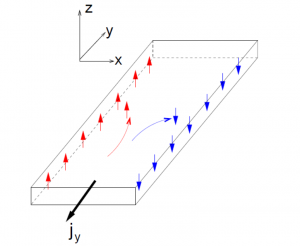
Fig. 1. 2D sample. Electron current flows in y direction and electrons with opposite spins in z direction are accumulated on the sample edge in x direction.
For all the reported quantities we use the effective atomic units (a.u.*). Typical magnitudes in SI and a.u.* units used are presented in Tab.1.
Tab. 1. Typical magnitudes of electrons density (n), current density (j), step in confining potential energy (V1), spin-orbit coupling () and the Fermi energy (EF) in SI and a.u.* units..
| SI | a. u.* | |
|---|---|---|
| N | 1.04 x 1012 cm-2 | 1.0 |
| J | 2.8 x 10-6 A/ |
0.01 |
| V1 | 2.72 eV | 229 |
| |
4.6 x 10 -10 m | 5.53 x 10 -4 |
| E F | 35.28 meV | 3.01 |
The Schrödinger equation for the x-dependent part of the wavefunction for this model is:
| (1) |
where and ky is a quantum wave number in y direction, V(x) is potential energy from sample edges that confines electrons within the sample and
is a small correction, which is spin-dependent and essential for the appearance of the spin polarisation. In the following we will consider two different physical mechanisms responsible for the spin-dependent potential.
SPIN SEPARATION BY SPIN-ORBITAL INTERACTION
In case of spin-orbit interaction the term is
, which has simple form
| (2) |
where is Pauli matrix,
for GaAs [4].
We computed the spin polarisation only for one edge of the sample with the model potential shown in Fig. 2.
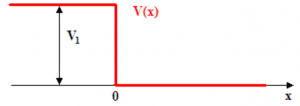
Fig. 2. Dependence of potential on the left edge of the sample.
The spin polarisation is obtained as a difference between the densities of “spin up” and “spin down” electrons. The latter is computed directly from the wavefunctions fulfilling Eq. 1. The other parameters specifying the presented calculation are: total bulk electronic density n =0.958 and the current density j=0.05. The resulting spin polarisation, shown in Fig.3, shows a pronounced maximum of the spin-down electrons near the left edge of the sample.
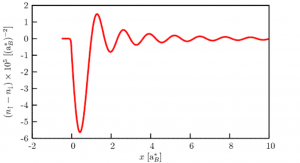
Fig. 3. The spin polarisation in x direction exhibits Friedel-like oscillations near the left edge of sample.
The magnetization per unit length of the sample (in y direction) is obtained by integration,
| (3) |
Its dependence on the current density at constant electron density n = 0.958 is in Fig. 4. We see that magnetization grows linearly with the current density with the slope dM/dj = -5.5×10-4, in agreement with previous theoretical work [6]. Furthermore, in [2] it has been found that the magnetization is independent of the electron density.
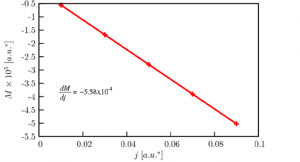
Fig. 4. Evidently linear dependence of the magnetization on the current density (electron density n = 0.958).
SPIN SEPARATION BY INDUCED MAGNETIC FIELD
Here, the source of the spin-dependent potential energy is the magnetic field induced by the current in the sample. Since the field has large extent, we have considered both edges of the sample with the total width in the x direction 100aB*.
We have computed the current density directly from the eigen-functions of the Schrödinger equation (for the details see [3]) which subsequently gave the induced magnetic field according to the relation [5]
| (4) |
where the magnetic permeability accounts for the paramagnetic substrate. For
the magnetic field is at most twice as large as in the case without the paramagnetic substrate. Therefore, the presence of the substrate has no significant influence on the polarisation.
Magnetic field imposes spin-dependent potential energy in the Schrödinger equation (Eq. 1), , (its value in a.u.* is ~ 10-6). We have computed the difference in the electron density in the x direction for electrons with opposite spins using perturbation method, Fig. 5, with j = 0.05. Since both edges were used, we see both – the “spin-down” electrons dominant near the left edge of the sample, as well as the “spin-up” electrons dominant near the right edge of the sample. Similarly to the case with the spin-orbit interaction (Fig. 3), the Friedel oscillations are visible. Polarisation caused by the induced magnetic field is of the same order as polarisation caused by spin-orbit interaction.
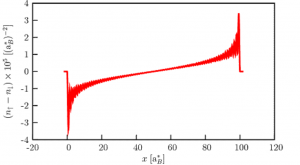
Fig. 5. Difference of electron density in x direction for electrons with opposite spins by sample width 100 aB* due to current-induced magnetic field.
CONCLUSIONS
We have studied the influence of the edge potential on spin polarisation. The calculated magnetization corresponds to 1 uncompensated spin per 20 000 electrons. The spin polarisation caused by the induced magnetic field was 1 uncompensated spin per 25 000 electrons. Hence the polarisation caused by the induced magnetic field is comparable with polarisation induced by spin-orbit interaction. The presence of paramagnetic substrate has marginal influence on the polarisation.
ACKNOWLEDGMENT: We acknowledge the support of Slovak Grant Agency VEGA (Project No. 1/0452/09).
REFERENCES
- V. Sih, Y. K. Kato, D. D. Awschalom, Physics World 18, 33 (2005)
- Horváth, F.: Spinový Hallov jav – indukcia spinovej polarizácie spin-orbitálnou interakciou. Bratislva:FEI STU, 2009. Master Thesis
- Kičínová, L.: Spinový Hallov jav – indukcia polarizácie vnútorným magnetickým poľom. Bratislva:FEI STU, 2009. Master Thesis
- H. A. Engel, B. I. Halperin, E.I. Rashba, Phys. Rev. 95, 166605 (2005)
- D. Mayer, J. Polák: Metody řešení elektrických a magnetických polí, Státní nakladatelství literatury, Praha 1983
- P. Bokes, F. Corsetti and R. Godby, Phys. Rev. Lett. 101, 046402 (2008).
Co-authors of this paper are Peter Bokes, Lucia Kičínová, Jaroslav Tóbik, Slovak University of Technology, Faculty of Electrical Engineering and Information Technology, Ilkovičova 3, 812 19 Bratislava.

